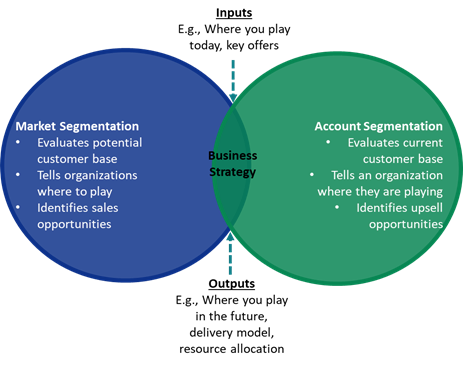Using Segmentation as a Measuring Stick
How does your organization do annual planning or establish its targets and goals for the next year? Is it a top-down percentage growth with a target margin threshold? Is it business unit specific and bottom-up using this year’s run-rate, current account opportunities, recurring revenue projections, and more? Every organization does annual planning a bit differently, but for most organizations, there is an element of reflecting on the past as well as setting intentions for the future. Almost all companies can agree that to determine where one needs to go, they must first have a clear view of their current position.
So, what metrics are typically relied upon during this reflection and goal setting process?
Understandably, companies often default to financials as baseline indicators for organizational health and performance. While financials tell a strong story about operations, efficiency, and growth, they may veil the story behind a company’s strategic performance. Following a volatile, unpredictable year, market shifts forced numerous companies into unprecedented territory. Though many companies prevailed financially, successfully adapting to the changes presented, some adjusted at the sake of their long-term strategies. They moved away from their core where to play and how to play approaches to pursue short-term revenue. This may have worked temporarily, and for some, this may have charted a new (permanent) strategic direction, but most organizations are beginning to find their way back to their old strategies as we get into this new year.
Finding the path back to their strategic core requires reflection and analysis; account and market segmentation is underutilized for this purpose but is an effective tool that provides both while offering insights and establishing a baseline from which an organization can build a strong future.
The snapshot of a company’s account and market segmentation is the manifestation of its strategy. It gives a company a view of where and how it is playing so it can better answer the question: is reality aligned to the strategy?

Account Segmentation
The goal of account segmentation is to evaluate a company’s current customer base to see the current size and offer penetration at each of its accounts to identify opportunities to better deploy resources to make a greater impact on those accounts most important to the organization today. Many organizations have defined goals and have designed a strategy to help them penetrate, become more impactful in, and upsell to what they believe are their top account types. Through account segmentation, however, many find that their current focus is misaligned with their overarching strategy – and the top accounts are not the ones the organization is most focused on maintaining.
Market Segmentation
Market segmentation leverages market demographic data to organize the market of potential buyers into groupings based on perceived value to an organization. In other words, market segmentation can help inform what a company’s strategy should be. Where in the market can an organization capitalize on the greatest growth and value? Answering this question will help companies understand who they should be selling to, and therefore, what they should be selling.
The Power of Account and Market Segmentation in Tandem
While both account and market segmentation provide strong insights independently, the combination of the two provides a holistic picture of the company’s strategy. For example, organizations often believe their largest accounts (account segments) are their “best” accounts, rather than also evaluating how saturated those accounts are and how much growth is available (market segments). This belief gets an organization by for a while, but eventually it becomes difficult to hit double-digit growth goals when you continue tapping on the same well. By the time organizations realize this organically, offer strategy and resource investments are no longer directed at the portions of the market that now need the most growth and investment. By looking at the account and market segments together, and their trends over time, companies are better able to understand and prioritize the accounts that are most important to them, now and in the future, and build strategies accordingly. It causes leaders to ask the following critical questions:
- Do we have the correct strategy in place?
- Has my organization committed to our strategy?
- Is our current situation a product of our approach or a product of the market?
- How should we shift our investments and focus to better support our desired strategy?
Once these questions are answered, companies can ensure their plans are realistic, their efforts are focused on achieving their strategic objectives, and they have a non-financial baseline to measure future decisions against.
Written by: Anthony Paluska
About the Author: Anthony Paluska is a Partner at McMann & Ransford with experience helping organizations overcome commoditization by developing stronger, more intimate, relationships with their customers. He has leveraged his management consulting, problem-solving, and change management skills to support 15+ Fortune 1000 organizations, across a multitude of industries.
